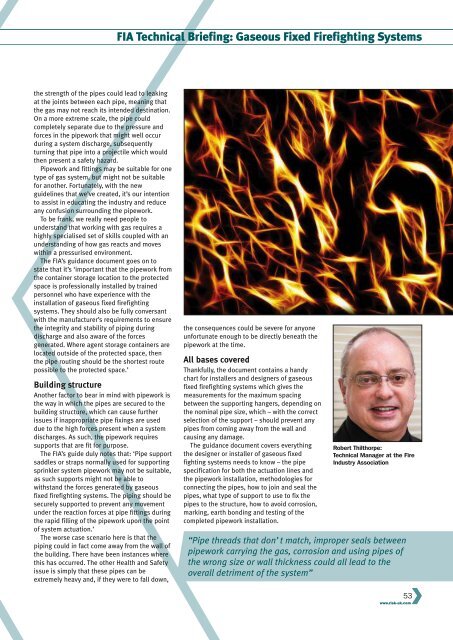RiskUKSeptember2017
You also want an ePaper? Increase the reach of your titles
YUMPU automatically turns print PDFs into web optimized ePapers that Google loves.
FIA Technical Briefing: Gaseous Fixed Firefighting Systems<br />
the strength of the pipes could lead to leaking<br />
at the joints between each pipe, meaning that<br />
the gas may not reach its intended destination.<br />
On a more extreme scale, the pipe could<br />
completely separate due to the pressure and<br />
forces in the pipework that might well occur<br />
during a system discharge, subsequently<br />
turning that pipe into a projectile which would<br />
then present a safety hazard.<br />
Pipework and fittings may be suitable for one<br />
type of gas system, but might not be suitable<br />
for another. Fortunately, with the new<br />
guidelines that we’ve created, it’s our intention<br />
to assist in educating the industry and reduce<br />
any confusion surrounding the pipework.<br />
To be frank, we really need people to<br />
understand that working with gas requires a<br />
highly specialised set of skills coupled with an<br />
understanding of how gas reacts and moves<br />
within a pressurised environment.<br />
The FIA’s guidance document goes on to<br />
state that it’s ‘important that the pipework from<br />
the container storage location to the protected<br />
space is professionally installed by trained<br />
personnel who have experience with the<br />
installation of gaseous fixed firefighting<br />
systems. They should also be fully conversant<br />
with the manufacturer’s requirements to ensure<br />
the integrity and stability of piping during<br />
discharge and also aware of the forces<br />
generated. Where agent storage containers are<br />
located outside of the protected space, then<br />
the pipe routing should be the shortest route<br />
possible to the protected space.’<br />
Building structure<br />
Another factor to bear in mind with pipework is<br />
the way in which the pipes are secured to the<br />
building structure, which can cause further<br />
issues if inappropriate pipe fixings are used<br />
due to the high forces present when a system<br />
discharges. As such, the pipework requires<br />
supports that are fit for purpose.<br />
The FIA’s guide duly notes that: ‘Pipe support<br />
saddles or straps normally used for supporting<br />
sprinkler system pipework may not be suitable,<br />
as such supports might not be able to<br />
withstand the forces generated by gaseous<br />
fixed firefighting systems. The piping should be<br />
securely supported to prevent any movement<br />
under the reaction forces at pipe fittings during<br />
the rapid filling of the pipework upon the point<br />
of system actuation.’<br />
The worse case scenario here is that the<br />
piping could in fact come away from the wall of<br />
the building. There have been instances where<br />
this has occurred. The other Health and Safety<br />
issue is simply that these pipes can be<br />
extremely heavy and, if they were to fall down,<br />
the consequences could be severe for anyone<br />
unfortunate enough to be directly beneath the<br />
pipework at the time.<br />
All bases covered<br />
Thankfully, the document contains a handy<br />
chart for installers and designers of gaseous<br />
fixed firefighting systems which gives the<br />
measurements for the maximum spacing<br />
between the supporting hangers, depending on<br />
the nominal pipe size, which – with the correct<br />
selection of the support – should prevent any<br />
pipes from coming away from the wall and<br />
causing any damage.<br />
The guidance document covers everything<br />
the designer or installer of gaseous fixed<br />
fighting systems needs to know – the pipe<br />
specification for both the actuation lines and<br />
the pipework installation, methodologies for<br />
connecting the pipes, how to join and seal the<br />
pipes, what type of support to use to fix the<br />
pipes to the structure, how to avoid corrosion,<br />
marking, earth bonding and testing of the<br />
completed pipework installation.<br />
Robert Thilthorpe:<br />
Technical Manager at the Fire<br />
Industry Association<br />
“Pipe threads that don’t match, improper seals between<br />
pipework carrying the gas, corrosion and using pipes of<br />
the wrong size or wall thickness could all lead to the<br />
overall detriment of the system”<br />
53<br />
www.risk-uk.com

















